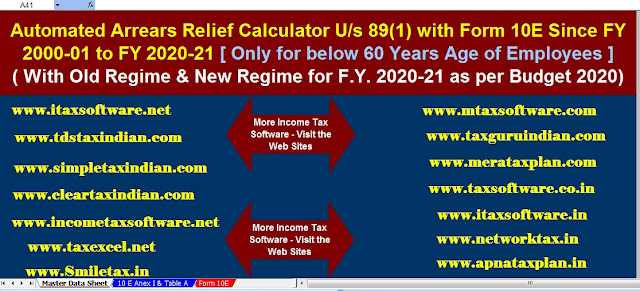Download Automated Excel Based Income Tax Arrears Relief Calculator with Form 10E from the F.Y. 2000-01 to F.Y.2020-21
Amount paid by the employer in the head of the arrears of salary, have you ever thought of tax
relief under section 89(1) on salary arrears: No,
Most of us don’t
know what is relief under section 89.
Most of the
employee says it “relief 89“.
What is relief under section 89
Calculation of
income tax depends on the income of the assessee, arrears is the part of
the income which was received in the current years of last year.
This means the
amounts which we suppose to get in the previous years is getting in the
current year.
The amount of
arrear turns your income higher and it will drag you to a higher tax slab.
Although the amount
received in the current years which is supposed to get in the previous year is
due to the process of the employer, you are liable for the tax, so what would
be the tax on salary arrears.
Income Tax Section
89(1) allow the assessee a relief under section 89(1) of the income tax act, to
mitigate such hardship.
To avail the
benefit of section 89(1), it is mandatory to fill a form 10e.
It is important to
understand the claim under section 89 (1) and fill the form 10E
How to calculate relief under section 89?
Relief
under section 89 with an example:
I like to an
example with you (How to claim relief under
section 89(1)), along with step by step process of ‘how to calculate relief
under section 89’ and to get the benefit of the reimbursement tax amount paid.
An amount of Rs. 1,00,000 in FY 2020-21 as
arrears which, I was supposed to get in FY 2016-17.
Step1: I am working in the multinational company and my
earning in FY 2020-21 including arrears
is Rs. 5,28,000,
tax computed for FY 2020-21 is Rs. 32,150.
Step2: on the other hand, IF my earning in FY 2020-21 excluding arrears is Rs. 4,28,000, tax computed for FY 2020-21
will be Rs. 22,350.
Step3: Subtracting the value of both the tax paid amount
is Rs. 9,800.
let’s go
back:
Step4: In FY 2014-15 my earning including arrears (if I received in
2014-15) is ₹ 3,51,000,
tax computed for FY 2014-15 will is ₹ 18,780.
Step5: In FY 2016-17 my earning excluding arrears (which is actual)
is Rs. 2,51,000, tax paid for FY 2016-17
is Rs. 12,780.
Step6: After Subtracting the value of both the tax paid
amount is Rs. 6,050.
In the
Final step 7:
Subtracting both
the differences we get Rs. 3750
That is the amount
we can get relief under section 89(1) of income tax act by filling form 10E.
So, in this case,
tax relief will be Rs. 3750.
Whatis Form 10E?
To claim the amount
back under section 89(1) which was paid to due arrears, it is mandatory to fill
the form without filling the fill you cannot claim back the amount. Form 10E
allows you to enter all the income and deduction details of all years.










No comments:
Post a Comment